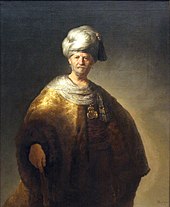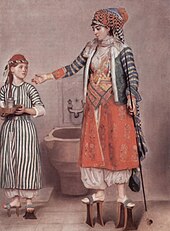Turquerie
Turquerie (anglicized as "Turkery"), or Turquoiserie,[1] was the Turkish fashion in Western Europe from the 16th to 18th centuries for imitating aspects of Ottoman art and culture.
This fashionable phenomenon became more popular through trading routes and increased diplomatic relationships between the Ottomans and the European nations, exemplified by the Franco-Ottoman alliance in 1715.
[4] At the same time the Ottomans were slowly ceasing to be regarded as a serious military threat to Western Europe, despite their continuing occupation of the Balkans, and campaigns such as that ended by the Battle of Vienna as late as 1683.
Ottoman scholars—who had been studying the plant for centuries and were producing relevant, new sources—became the main reference for Edward Pococke and Antoine Galland’s written works on coffee.
Adhering to strict instructions, sequences, and measures, good coffee had to be prepared with a precision that the Ottomans had perfected, a skillset that Europeans had yet to learn to apply to their version of the bitter, crude drink.
Europeans did not regard Ottomans as rivals that they had to contend with and imitate militarily, politically, or diplomatically, but rather as an exotic foreign people possessing quaint and strange fashions that could be consumed.
[10] These "obsessions" with Turkish aesthetics were in part brought on by the presence of Europeans in the Ottoman Court and the acts of bringing back their products to Europe.
[11] The increased mercantile relationships between the Turkish people and the Europeans aided this process; the continuation of these trading systems helped to spread new fashions quickly in Europe.
[12] Fabrics were often bright, rich, and embroidered, as depicted in the painting, Himan de la Grande Mosquee by Joseph-Marie Vien in 1748.
[13] Social position was something very important in the 18th century so things like dress, posture, and props were carefully selected in order to communicate one's status.
This included wearing loose, flowing gowns belted with ornate bands of embroidered cloth and ermine-trimmed robes with tasseled turbans.
Writing also contributed to the visual aspect of Turkish cultural exchange and perhaps the most influential transformation into the turquerie vogue in Europe was done by Lady Mary Wortley Montagu.
Her collected letters describing Turkish fashion were widely distributed in manuscript form in her social circle and were then printed for the public upon her death in 1762.
Traditional Turkish music included wavering pitches, microtones, arabesques, different scale systems, and non-Western rhythmic patterns.
[18] In music, Orientalism may be applied to styles occurring in different periods, such as the alla turca, used by multiple composers including Mozart and Beethoven.
One of France’s most important opera genres was tragédie en musique, depicted by Scanderberg, with music by François Rebel and Francois Francoeur, set to a libretto by Antoine Houdar de la Motte in 1735.






